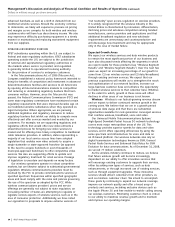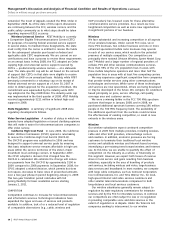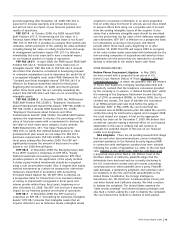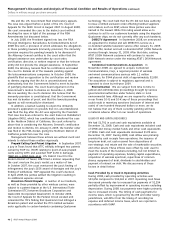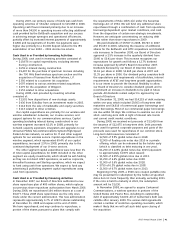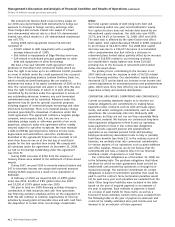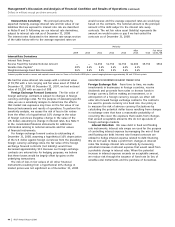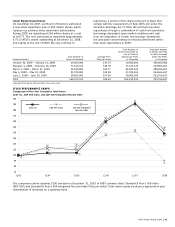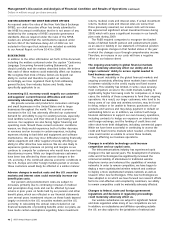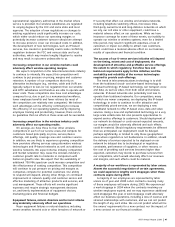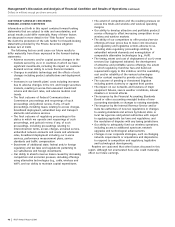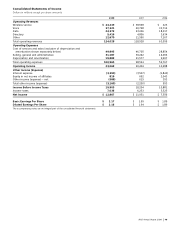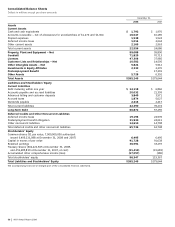AT&T Wireless 2008 Annual Report Download - page 42
Download and view the complete annual report
Please find page 42 of the 2008 AT&T Wireless annual report below. You can navigate through the pages in the report by either clicking on the pages listed below, or by using the keyword search tool below to find specific information within the annual report.
Management’s Discussion and Analysis of Financial Condition and Results of Operations (continued)
Dollars in millions except per share amounts
40
| AT&T Annual Report 2008
We and the U.S. Government filed interlocutory appeals.
The case was argued before a panel of the U.S. Court of
Appeals for the Ninth Circuit in August 2007. In August 2008,
the court remanded the case to the district court without
deciding the issue in light of the passage of the FISA
Amendments Act discussed below.
In July 2008, the President signed into law, the FISA
(Foreign Intelligence Surveillance Act) Amendments Act of
2008 (the Act), a provision of which addresses the allegations
in these pending lawsuits (immunity provision). The immunity
provision requires the pending lawsuits to be dismissed if
the Attorney General certifies to the court either that the
alleged assistance was undertaken by court order,
certification, directive, or written request or that the telecom
entity did not provide the alleged assistance. In September
2008, the Attorney General filed his certification and asked
the court to dismiss all of the lawsuits pending against
the telecommunications companies. In October 2008, the
plaintiffs filed an opposition to the certification and motion
to dismiss arguing that the Act is unconstitutional and,
alternatively, that the Government failed to meet its burden
of justifying dismissal. The court heard argument on the
Government’s motion to dismiss on December 2, 2008.
We are awaiting the court’s decision. We believe that the
immunity provision is constitutional, that the Government
has met its burden of proof, and that the lawsuits pending
against us will eventually be dismissed.
In addition, a lawsuit seeking to enjoin the immunity
provision’s application on grounds that it is unconstitutional
was filed the day after the Act was signed by the President.
That case has been referred to the Joint Panel on Multidistrict
Litigation (MDL), which has conditionally transferred the case
to the Northern District of California, the court referred to
above that is considering the Attorney General’s certification
and motion to dismiss. On January 6, 2009, the transfer order
was filed in the MDL docket, giving the Northern District of
California jurisdiction over the case.
Management believes these actions are without merit and
intends to defend these matters vigorously.
Prepaid Calling Card Patent Litigation In September 2007,
a jury in Texas found that ATTC willfully infringed two patents
owned by TGIP Inc. (TGIP) relating to point-of-sale prepaid
cards sold by ATTC and awarded TGIP $156 in damages.
(TGIP Inc. v. AT&T Corp. et al., U.S. District Court for the
Eastern District of Texas). AT&T filed a motion requesting that
the court overturn the jury’s verdict as a matter of law.
In October 2007, the court overturned the jury’s finding of
infringement, the jury’s $156 award of damages and the jury’s
finding of willfulness. TGIP appealed the court’s decision.
In April 2008, the parties settled the litigation resulting in
no additional expense accrual.
Broadcom Patent Dispute A number of our handsets,
as well as those provided by other wireless carriers, were
subject to a patent dispute at the U.S. International Trade
Commission (ITC) between Broadcom Corporation and
Qualcomm Incorporated (Qualcomm). In October 2008,
the Court of Appeals for the Federal Circuit vacated and
remanded the ITC’s finding that Qualcomm had infringed a
Broadcom patent and vacated the ITC’s limited exclusion
order applicable to certain handsets containing Qualcomm
technology. The court held that the ITC did not have authority
to issue a limited exclusion order affecting handset suppliers
and retailers, such as AT&T, unless those parties were also
named in the lawsuit. While this ruling would allow us to
continue to sell to our customers handsets using the disputed
Qualcomm chips, we do not currently offer any such handsets.
DIRECTV Agreement In September 2008, we announced
an agreement to market and sell DIRECTV’s service as a
co-branded satellite television service after January 31, 2009.
We did offer, market and sell co-branded AT&T|DISHNetwork
services through January 31, 2009. After that date, existing
AT&T|DISHNetwork customers will continue to receive
DISH Network service under the existing AT&T|DISHNetwork
agreement.
Centennial Communications Acquisition In
November 2008, we agreed to acquire Centennial
Communications, Corp., a regional provider of wireless
and wired communications services with 1.1 million
customers, for $944 plus net debt of approximately $2,000.
The acquisition is subject to regulatory approval and is
expected to close by mid-year 2009.
Environmental We aresubject from time to time to
judicial and administrative proceedings brought by various
governmental authorities under federal, state or local
environmental laws.Althoughwearerequired to reference
in our Forms 10-Q and 10-Kany of these proceedings that
could result in monetary sanctions (exclusive of interest and
costs) of one hundred thousand dollars or more, we do
notbelieve that any of them currently pending will have
a material adverse effect on our results of operations.
LIQUI D I T Y AND CAPITA L RE S O URCES
We had $1,792 in cash and cash equivalents available at
December 31, 2008. Cash and cash equivalents included cash
of $958 and money market funds and other cash equivalents
of $834. Cash and cash equivalents decreased $178 since
December 31, 2007. During 2008, cash inflow was primarily
provided by cash receipts from operations, the issuance of
long-term debt, net cash received from dispositions of
non-strategic real estate and the sale of marketable securities
and other assets. These inflows were offset by cash used to
meet the needs of the business including, but not limited to,
payment of operating expenses, funding capital expenditures,
acquisition of wireless spectrum, repurchase of common
shares, repayment of debt, dividends to stockholders and
payment of interest on debt. We discuss many of these
factors in detail below.
Cash Provided by or Used in Operating Activities
During 2008, cash provided by operating activities was
$33,656 compared to $34,242 in 2007. Operating cash flows
decreased primarily due to increased tax payments of $1,294
partially offset by improvement in operating income excluding
depreciation. During 2008, tax payments were higher primarily
due to increased income. The timing of cash payments for
income taxes, which is governed by the IRS and other taxing
jurisdictions, will differ from the timing of recording tax
expense and deferred income taxes, which are reported in
accordance with GAAP.






